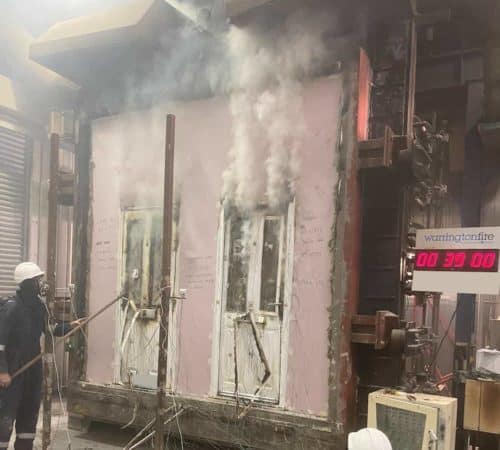Fire Protection – Fall & Rise of the GRP Composite Fire Door
Posted: 8th June 2021
It’s been a challenging time for the GRP composite fire door industry. Issues with consistent fire-resistant performance have been a catalyst for change – robust testing, third party certification and transparency in the supply chain. Dave Walker, technical director for Distinction Doors explains more…
During the post-Grenfell investigation, two undamaged flat entrance doors were removed from areas that were not affected by the fire and were subjected to BS 476-22 fire testing. Test results showed that the doors failed at just 15 minutes. The failure was reported to Ministry for Housing Communities and Local Government (MHCLG).
Further tests conducted by MHCLG, using doorsets from the same manufacturer removed from existing installations, concluded inconsistent results – anything from 14 to 40 minutes. The tests were carried out with the doorsets opening into the furnace.
This inconsistency sparked a thorough investigation of the fire door industry by MHCLG.
One Direction
Prior to the fire at Grenfell Tower, it was accepted practice that fire door testing should be carried out with the door hung so that it opened-in, towards the furnace – testing from both sides was not required.
Single directional testing was based on the experience of notified bodies and test laboratories fully accredited by the United Kingdom Accreditation Service (UKAS). Opening into the furnace was deemed the most onerous direction, and so if this most onerous side passed, then there was no need to test the other. The Government test programme proved that this assumption (while true in most cases) was flawed.
Catalyst for Change
While Annex A of Approved Document B (Fire Safety) allowed for the assessment of the most onerous direction for test, Appendix B (Performance of materials, products and structures) states that the tests be conducted on two doorsets, one hung opening into and one hung opening away from the furnace.
The Ministry published its findings in 2019. The documents revealed that three quarters of glass reinforced polyester (GRP) composite fire doors failed furnace tests.
Representing a sample of the market, just three of the 12 GRP composite fire doors tested by the British government achieved 30 minutes fire resistance, as required by Building Regulations. The doors failed for a range of reasons including performance at the glass, letterbox and door frame.
It was concluded that there were ‘performance issues’ with GRP composite 30-minute fire doors ‘across the market’, although it was noted that context must be given for the results which represent ‘only a sample of the market and are only relevant for the specific model of doorset tested from the manufacturers’.
More than two years’ have passed since the GRP composite fire door report was published and I can assure you that the industry has been proactive in its response. Key areas include third party certification, traceability and robust testing.
Tried and Tested
At the heart of this overhaul is robust testing. Under Appendix C: Fire doorsets of the latest version of Approved Document B ‘The requirement is for test exposure from each side of the doorset separately.’ One GRP composite fire door system supplier has raised the bar, satisfying not just the British Standard (BS 476-22 Fire resistance and smoke control tests for door and shutter assemblies, openable windows and elements of building hardware) but also the more demanding European test method standard BS EN 1634-1.
The company subjected 44 doorsets to 22 bi-directional fire tests. The tests were conducted in three countries, using three variations of supporting wall construction – 150mm and 225mm rigid aerated block and flexible steel stud construction.
The test specimens included solid and glazed door leaf options, either with or without overhead fan lights and all doorsets were tested with letterplates, viewers and door closers included. All featured auto-throw locks.
Every fire test was filmed. The system achieved an average of 45 minutes integrity.
This level of commitment and robust testing has sent a clear message to the UK construction industry; you can achieve consistent fire resistance, compliance and peace of mind with GRP composite fire doors. It also proves that we can meet recommendations outlined in the Building a Safer Future – Independent Review of Building Regulations and Fire Safety: Final Report:
Recommendation 7.1: A clearer, more transparent and more effective specification and testing regime of construction products must be developed. This should include products as they are put together as part of a system.
Third Party Certification
Third party certification is required in many areas of UK construction, including gas and electricity, and yet there is no such thing for fire safety. The demonstration of professional competence in fire safety is non-mandatory. How is that possible?
Since Grenfell several GRP composite fire door system houses, and members of the Association of Composite Door Manufacturers, have gained third party certification and taken control of their supply chain. This not only significantly reduces risk but also promotes stake-holder confidence. It also goes some way to meet the demand for improved product traceability.
One system supplier now insists that all stages of the supply chain up to and including doorset manufacture are third-party certified to the BM Trada Q-Mark Fire Door Manufacturer certification scheme.
Its door blank meets the requirements of the Q-Mark Door Blank scheme to STD 047 and the fire entrance door range is stocked and distributed under Q-Mark STD 171/050 for fire resistance and PAS24 enhanced security.
It is available across the UK through a network of official doorset manufacturing partners, each selected, audited and tested to meet the non-mandatory requirements of Q-Mark STD 170/050, to demonstrate and prove competence in manufacturing the system with a robust factory production control process.
By choosing to mandate the supply chain, this system supplier has more autonomy and control than its competitors. It can control all components apart from door closers and sealed units; however, these must match the tested specification.
But what does this mean for the fire door?
It means less dilution of the product throughout the supply chain. With this system, for example, the door blank and frame are pre-machined, so the hardware locates positively, the intumescent is pre-applied and the letterplate also features pre-applied intumescent.
The Future – Digitalisation
Installation and maintenance are critical in the life cycle of these products. While great strides have been taken with the supply chain, for me, significant change will only occur if we can encourage installers to be certified and maintenance teams are empowered through product knowledge and access to data.
As custodian of a system which offers protection for both life and property in the event of a fire, my aim is to establish a future-proof technology which will close the loop on supply and maintenance – utilising chips for key data storage.
In fact, I’m extremely hopeful that this will soon be a reality as the Building a Safer Future report recommends ‘the creation and use of the digital record throughout the building life cycle…The purpose of the digital record is to ensure that accurate building information is securely created, updated and accessible…’
The report goes on to recommend that a Building Information Modelling approach is phased in for new builds. With BIM level 2 mandatory on centrally procured projects since April 2016, the review believes ‘The digital maturity of the UK construction industry has now grown to be able to deliver digital asset data, and increasingly work in a BIM compliant way.’
As we look to a safer, more compliant future, and with plans to progress the Building Safety Bill announced in this year’s Queen’s Speech – establishing in law a new Building Safety Regulator – I am confident that people will be, and will feel, safer in their homes.
As featured in, and reproduced with kind permission of International Fire Protection

